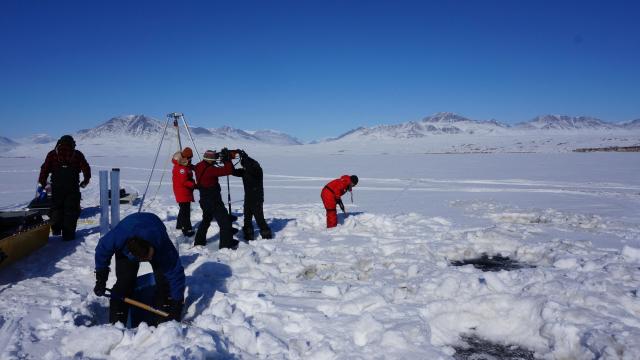In the Canadian High Arctic, climate change is bringing together viruses and potential hosts in new combinations, according to recently published research. Every novel interaction increases the risk of “viral spillover,” i.e., pathogens jumping to different hosts. And every instance of spillover is an opportunity for a virus to become more dangerous.
Viruses rely on their hosts to replicate and spread, yet most viruses are intricately co-evolved with the organisms that support them. Hosts develop defences that viruses must work to overcome. But in instances of spillover — where a virus jumps ship to a new life form — hosts lack evolved immunity. As with the covid-19 pandemic, when a virus finds a new host for the first time, the results can be catastrophic.
In a glacier-fed lake in the High Arctic, more meltwater means more chance of viral spillover, says the new study published in the journal Proceedings of the Royal Society B. Researchers sampled sediment from Lake Hazen, the world’s largest High Arctic lake, and sequenced the viral RNA as well as DNA from animals, plants, and fungi inside.
They found that, in areas of the lake where glacial run-off is highest, the evolutionary overlap between viruses and possible host organisms is lowest, indicating less shared history and more opportunities for unfortunate cross-overs. And climate change is increasing run-off nearly everywhere glaciers exist on Earth.
Glaciers are ancient ice. As they formed thousands or tens-of-thousands of years ago (or even a million years ago), they became time capsules of their environment — trapping organic material, rocks, and pathogens in their matrix. And, as glaciers (or permafrost) melt under climate change, they’re releasing those same things back into our rapidly shifting world.
“This is more evidence that climate change is leading to more problems,” said senior study scientist Stéphane Aris-Brosou, a computational biologist at the University of Ottawa, in a video call. The researcher said he was surprised that he and his co-researchers found such a correlation between glacial run-off and spillover risk. But now that they have, he wouldn’t be surprised to see a new pandemic virus — be it fungal, plant, or animal — emerge from glacial melt.
Though, Aris-Brosou was careful to emphasise, “we are not predicting the next pandemic” and especially not the next big human viral explosion. The single study of lake sediments is not a crystal ball. “We’re not predicting when, where, in which host, or which viruses are going to lead to the next pandemic — not anything like that,” he said.
Spillover events don’t necessarily mean a pandemic, and the overwhelming majority of viruses don’t infect people. Plus, Aris-Brosou and his colleagues didn’t capture spillover actually happening or even identify the specific viruses present in the glacial sediment. Instead, they took a broad approach, assessing how much melt has muddled together various genetic histories within Lake Hazen.
Previous research has similarly found that climate change is boosting the chance of spillover events, such as by forcing animals into different habitats. But the new study is the first of its kind to quantify spillover risk by sequencing all of the genetic data present in an environment, according to the study authors. “To our knowledge, this is the first attempt to assess the complete virosphere of both DNA and RNA viruses, and their spillover capacity,” they wrote in their paper.
Because it’s a new approach, Aris-Brosou pointed out that there are big limitations to their findings. For one, there’s no information out there for comparison. The researchers were able to determine that spillover risk increases with glacial melt in lake sediment, but they can’t say how high the risk of viral spillover is in Lake Hazen relative to any other place in the world. “We don’t have a sense of scale for this, right now,” Aris-Brosou said.
Further, because they sequenced such a large pool of genetic information, their findings lack specificity. Right now, the scientists can’t say exactly what viruses are lurking at the bottom of the lake, or even what proportion are still infectious. But in follow-up work that’s already underway, Aris-Brosou is hoping to determine how closely related the viruses they found are to present-day pathogens and if any are new to science entirely.
Nonetheless, the results highlight a little-studied side effect of climate change. Through the burning of fossil fuels, we’re altering everything about our world, down to the interactions between life and viruses at the bottom of a glacial lake. “We are the essential drivers of this situation,” said Aris-Brosou. And so, “we need to think carefully about the ways we conduct our lives.” Otherwise, the rising risk of spillover and any resulting, future pandemics are a consequence we’ll have to live with.
